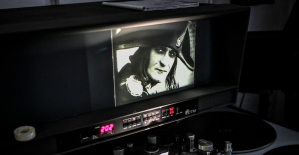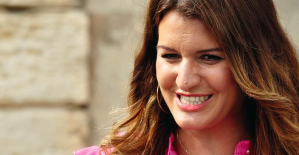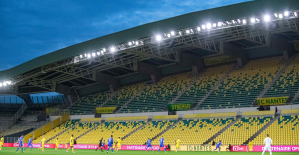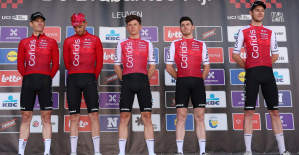It is not längdåkarbiografier in Norway. No other country has more, especially per capita.
It has generally hagiografins ritual structure: the trials, a turning point and a triumph. Gamely, often even moral. Good triumphs for the most part. The books are the puritan. The main character returns after battles and victories in Europe and Sweden, often home to the farm, like the prodigal son. Predictability is a nuisance, but not really different than in the tv-series and detective stories. The audience knows what it wants.
This does not mean that there is a strong and gripping stories. Inger Wigernæs ”Against targets with jentutn” (1967) is full of sarcastic irony and sharp syrligheter an official Skidnorge that as late as 1958, in a survey in Aftenposten voted to liquidate the Norwegian championship for ladies. They were both the bad and the ugly, I thought after the disastrous world CUP in Lahti the same year.
the ghost writer. They are rarely really justified. Prose is konstlös, also the ritual. Wigernæs wrote itself, it was the secret of her. Another that wrote itself was Siri Halle, rebel, with his short but intensive career. ”Sporet fanger” (1998) addresses the false expectations, gender stereotypes, the sport's bleak politics. It makes it immediately more interesting. But it is so rare.
as rare as Gudmund Skjeldals book about her brother, Christian, ”The last langrennaren”, a criticism of civilization with roots in the lutheran missionärshemmet in western norway. Skjeldal belong to the country's best in the branch idrottsessäistik, with fine books on the ”Wimbledon” (2017) and coming in second – ”Nestbest: Ei personal idéhistorie on the gull, sølv og bronse” (2015).
Publikhav meet the riders in Holmenkollen. Photo: Nesvold, Jon OlavWith Skjeldals broderporträtt ushered in a renewal of the skidbiografin in Norway. A literary wind has blown in over the tracks and makes it all the more interesting to read, for example, Thorkild Gundersens samtalsbok ”What jeg snakker if reaches jeg snakker if langrenn”. Skidbiografin extends now out to the existential and against what it means to live as a modern man in klimatkrisens hot. The national yoke starts to be lifted, and there emerges a liberating disagreement about what all goes on.
to the codend of the genre is Thor Gotaas. Since the turn of the century, he has published more than thirty books, the majority of längdlöpning. Many are biographies. The latest is the ”Oddvar Brå – et skilöperliv” (Gyldendal). Gotaas is not just a ghost writer. He is also the ethnologist. The combination is unique. His books have a documentary move, as if it actually deals with folklore. On etnologers way he uses the interviewees, ”informants”, as the sources – more than a hundred pieces in the book about the Crime. He seems to be the sources of the faithful, in any case, he depicts a very large number of miraculous details that need to be descended from them. The book gets a little overloaded, but a large part of the readership is certainly geeks and they can never get enough, so that's okay.
Thor Gotaas has thus been able to make relatively independent of skidlöparen itself. He is also open to what shapes the life around.
You may know lots. A race is told not only by the skidlöparen. Of Gotaas, it is on the contrary a diversity of voices. The races seen through different eyes, and also the media, the people. It gets to the end of what anthropologists like to call a ”thick description”, a dense representation, which speaks through nouns and attention to detail. The reader should have patience enough to hear about the many training sessions and many ski races. If the skis also. Oddvar found himself in the transition between wood and plastic. He had decided to go for Fischer, but repented and went back to the Landsem. Probably it was to his detriment.
Oddvar Brå (to the right) together with Ivar Formo in Oslo in 1970. Photo: Aaserud, Ivarand wise in the book. Oddvar get a letter, phone call, face the audience at airports and restaurants. Generally well-liked. The Norwegian people do things all the time, that he should remain a bachelor, for no one is good enough to one's idol. Topic after topic line up: illness, fellowship, media, physiology. On just about every subject there is knowledge, research. But Gotaas is not working so. He has hundred of informants, but cites only a handful of books. It makes him strong on the concrete, the weaker the ideas, the larger context.
Siri Halle depicted NM in Bodø in 1991 when the first war in the Persian gulf erupted. Skidmiljön reacted at all. One day the dog king Olav. When were the races. For Halle was such an important. Gotaas is more traditional: the Norwegian society, the wider framework is never quite present in him. There is always something more to say about skidvalla.
Gotaas portray skillfully in this sport changes, how stakningen will more and more with rullskidorna in the summer and the new laminate skis in the winter. How the east germans practice and how the norwegians learn. How the era Kristen Kvello and Oddmund Jensen – the legendary coaches on the fifty - and sextiotalen – go towards the end and how fysiologins findings looking into among the skeptical practitioners. The commercialization. The ever-growing träningsdoserna, in a time when skogsarbetet no longer was obvious. Brå, as well as the eternal friend and rival Ivar Formo, who was a student at the Norwegian Technical university in Trondheim, were the pioneers in to practice completely outside gårdsarbetet.
I have read hundreds of skidloppsskildringar in the Norwegian längdåkarbiografier. Northug delivers some of the best.
”tradisjonell biography”, admits Gotaas. It is also a little too loyal for that, and a little too prone to stating the obvious and truismer. What makes a rider very popular? Why is rivalry between swedes and norwegians? How does it feel to lose? To win? To break the rod, that Brå did in stafettduellen against Savjalov at the world CUP in Holmenkollen in 1982? Norway's largest idrottsminne, and the eternal question: ”where Were you when Brå broke the rod?”
Gotaas has reached farther than most. But it would go to dare to do more, both factual and literary. The book lives in the safety of recognition of joy, on collective memory. It rises above most in the genre but remains as a national confirmatory.
Jonas Forsangs book on Northug, is something completely different. There is only one voice, Northugs own. The book is also the name of it: ”My history”. No one else's. It is reminiscent of one of the most talked about, and best-selling, sportbiografierna in modern times: ”I am Zlatan” – with David Lagercrantz, the responsive printers. In the same way, the writing here is not to tell you, for the ability to have both Zlatan and Northug, two of this decade's most välslängda cheeky jaws. It is about developing the voice, let its character, and dialect, heard for the reader. There is a deeper literary task.
With the success Forsang really good. He can listen, he can hear petter's dramaturgy, the rhythmic feel, pauseringen, the mind for the important details. Passengers. The book's key words.
skidloppsskildringar in the Norwegian längdåkarbiografier. Northug delivers some of the best. There is a kind of kongenialitet in the relationship between how he goes and how he tells them, as if both genres amuses him. And it must amuse the readers. Forsangs feature consists in that he removed the words rather than added. He understands the silences. And feelings. It works.
Much of the book is just as traditional as it use to be. Adversity in adolescence. The relationship with grandma and grandpa, ”Beste”, the memory of his voice, which he hears in the moments. He calls himself ”psychotic” prior to the Oslo world CUP 2011. How sacrifices and insane tenacity brings success to the end of the year. But here anas is also a certain level of complexity. It belongs to the concerning, in the book, how självinsikten will, sometimes too late. To friidrottaren Rachel Nordtømme abandon him after three years of relationship, he finds himself in retrospect, understandable. They had not grown apart – she had grown away from him. He was still standing at the starting line. You believe him.
You could say that he had not a life, but he won the ski races. When he wanted to get himself a life, he won't much anymore. Gotaas make an observation: the skier's face paint is almost always rosy, and elevated on the image, they are always nyduschade. Their single wake up time in the civil suit. Their fate: to always be nyduschade. A kind of stigma. The subjugation under a higher task.
Petter Northug in the German Oberstdorf 2016. Photo: Pedersen, Terje. First, five thick slices of bread for breakfast, then to eight thick slices of bread for lunch, then two hours of sleep and then another eight slices of bread before the day's second workout. Each slice of bread with mom's jam. So dinner with köttkakor (ten plus ten potatoes), or fish, or steak. Then supper with more slices of bread. In this way, the twelve days at a stretch. So a day of rest. Then the same cycle again.
Crime describes how he kappäter during his military service. He wins over a towering at 120 kilos by pressing, in itself, twenty-five köttkakor. He makes one thousand two hundred ski races. But at four hundred pages, he says nothing about art, literature, politics, aesthetics, architecture. It may depend on the Gotaas, or in some kind of code of conduct in skidbiografin.
It belongs to the genre's self-imposed philosophy, yet lingering. But both Forsang and Gotaas has still managed, in its way. Forsang/Northug has sold 100,000 copies in a country with five million inhabitants. This corresponds to eight million copies in the united states. It is on the Zlatannivå. It is more than Obama. It can only be explained by passion. A deeper form of passion. May is the Norwegian skidbiografier really helgonlegender.
Read more: Author P O Enquist writes about ”The genius”

 Iran-Israel conflict: what we know about the events of the night after the explosions in Isfahan
Iran-Israel conflict: what we know about the events of the night after the explosions in Isfahan Sydney: Assyrian bishop stabbed, conservative TikToker outspoken on Islam
Sydney: Assyrian bishop stabbed, conservative TikToker outspoken on Islam Torrential rains in Dubai: “The event is so intense that we cannot find analogues in our databases”
Torrential rains in Dubai: “The event is so intense that we cannot find analogues in our databases” Rishi Sunak wants a tobacco-free UK
Rishi Sunak wants a tobacco-free UK Alert on the return of whooping cough, a dangerous respiratory infection for babies
Alert on the return of whooping cough, a dangerous respiratory infection for babies Can relaxation, sophrology and meditation help with insomnia?
Can relaxation, sophrology and meditation help with insomnia? WHO concerned about spread of H5N1 avian flu to new species, including humans
WHO concerned about spread of H5N1 avian flu to new species, including humans New generation mosquito nets prove much more effective against malaria
New generation mosquito nets prove much more effective against malaria The A13 motorway closed in both directions for an “indefinite period” between Paris and Normandy
The A13 motorway closed in both directions for an “indefinite period” between Paris and Normandy The commitment to reduce taxes of 2 billion euros for households “will be kept”, assures Gabriel Attal
The commitment to reduce taxes of 2 billion euros for households “will be kept”, assures Gabriel Attal Unemployment insurance: Gabriel Attal leans more towards a tightening of affiliation conditions
Unemployment insurance: Gabriel Attal leans more towards a tightening of affiliation conditions “Shrinkflation”: soon posters on shelves to alert consumers
“Shrinkflation”: soon posters on shelves to alert consumers The restored first part of Abel Gance's Napoléon presented at Cannes Classics
The restored first part of Abel Gance's Napoléon presented at Cannes Classics Sting and Deep Purple once again on the bill at the next Montreux Jazz Festival
Sting and Deep Purple once again on the bill at the next Montreux Jazz Festival Rachida Dati: one hundred days of Culture on the credo of anti-elitism
Rachida Dati: one hundred days of Culture on the credo of anti-elitism The unbearable wait for Marlène Schiappa’s next masterpiece
The unbearable wait for Marlène Schiappa’s next masterpiece Skoda Kodiaq 2024: a 'beast' plug-in hybrid SUV
Skoda Kodiaq 2024: a 'beast' plug-in hybrid SUV Tesla launches a new Model Y with 600 km of autonomy at a "more accessible price"
Tesla launches a new Model Y with 600 km of autonomy at a "more accessible price" The 10 best-selling cars in March 2024 in Spain: sales fall due to Easter
The 10 best-selling cars in March 2024 in Spain: sales fall due to Easter A private jet company buys more than 100 flying cars
A private jet company buys more than 100 flying cars This is how housing prices have changed in Spain in the last decade
This is how housing prices have changed in Spain in the last decade The home mortgage firm drops 10% in January and interest soars to 3.46%
The home mortgage firm drops 10% in January and interest soars to 3.46% The jewel of the Rocío de Nagüeles urbanization: a dream villa in Marbella
The jewel of the Rocío de Nagüeles urbanization: a dream villa in Marbella Rental prices grow by 7.3% in February: where does it go up and where does it go down?
Rental prices grow by 7.3% in February: where does it go up and where does it go down? With the promise of a “real burst of authority”, Gabriel Attal provokes the ire of the opposition
With the promise of a “real burst of authority”, Gabriel Attal provokes the ire of the opposition Europeans: the schedule of debates to follow between now and June 9
Europeans: the schedule of debates to follow between now and June 9 Europeans: “In France, there is a left and there is a right,” assures Bellamy
Europeans: “In France, there is a left and there is a right,” assures Bellamy During the night of the economy, the right points out the budgetary flaws of the macronie
During the night of the economy, the right points out the budgetary flaws of the macronie These French cities that will boycott the World Cup in Qatar
These French cities that will boycott the World Cup in Qatar Champions League: France out of the race for 5th qualifying place
Champions League: France out of the race for 5th qualifying place Ligue 1: at what time and on which channel to watch Nantes-Rennes?
Ligue 1: at what time and on which channel to watch Nantes-Rennes? Marseille-Benfica: 2.99 million viewers watching OM’s victory on M6
Marseille-Benfica: 2.99 million viewers watching OM’s victory on M6 Cycling: Cofidis continues its professional adventure until 2028
Cycling: Cofidis continues its professional adventure until 2028


















